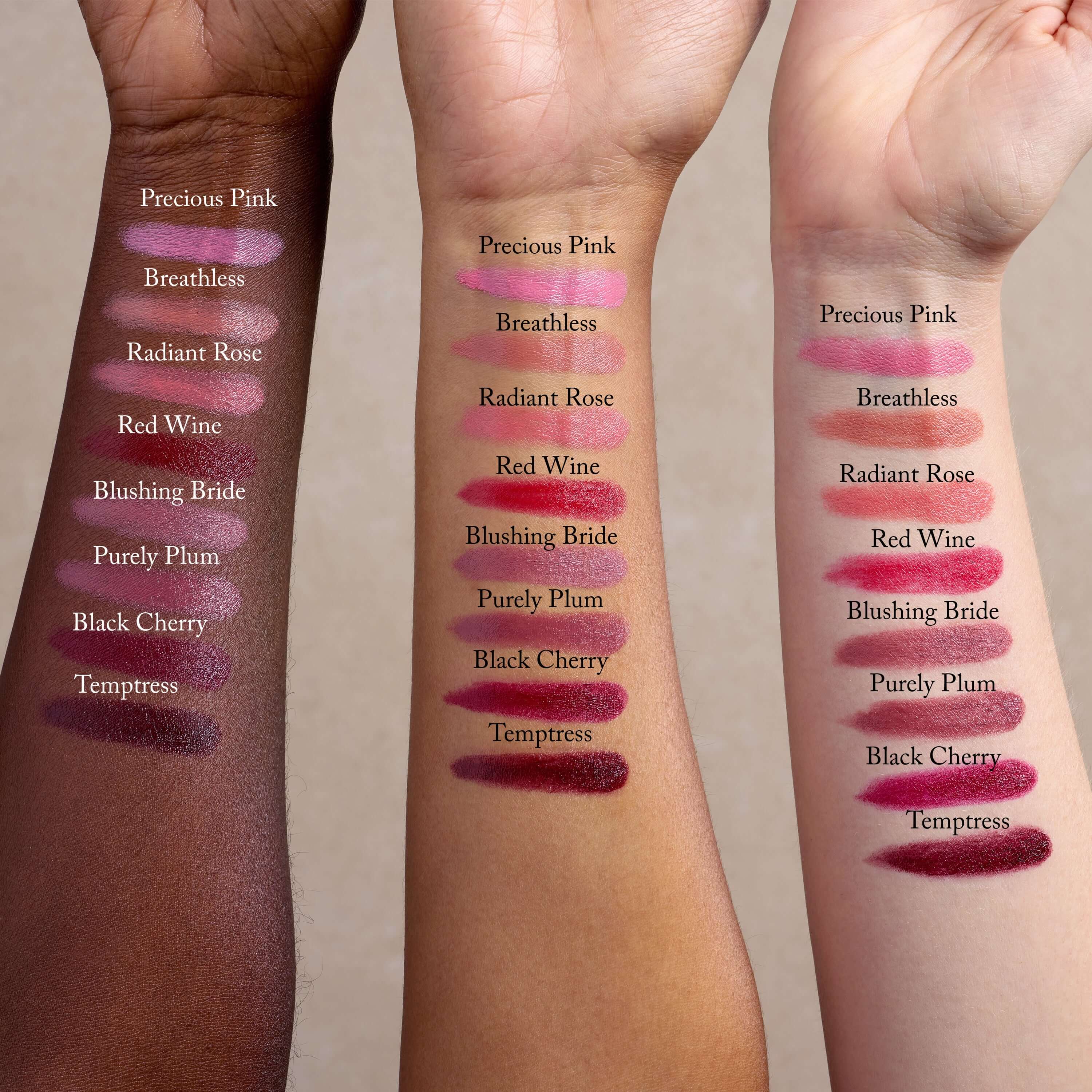When you choose the right lipstick color for your complexion, you’ll notice a difference. Your eyes are brighter, your cheeks are rosier, and your whole makeup look feels instantly elevated.
If you love a bold lip, then your makeup drawer is filled with every shade. Mulberry, warm beige, and peony pink are all on the table for your morning routine. But here’s the problem: not every lip color looks good with your complexion. Despite your general knowledge of the best colors for your skin tone, you can’t pinpoint the exact reason why some lipstick shades bring out your best features and others just fall flat.
If this is your lipstick experience, you’re missing one key detail: your skin’s undertone. Here, we’ll show you how to find that undertone and choose the best lipstick shade for your skin tone.
How to Find Your Lipstick Shade Match
Determine your undertone
Let’s get into some makeup science. Your undertone and your skin tone aren’t the same thing. In fact, they can be completely opposite.
Here’s the difference: your skin tone refers to the color of your skin (light, medium, or deep), while your undertone is the color below the surface.
Your undertone isn’t as obvious as your skin tone, but it plays a key role in color matching for lipstick, blush, and even foundation. When new makeup is created, the product’s undertone is always decided first. For instance, cool-toned makeup uses blue and purple hues for its base, while warm-toned makeup uses pink and red.
Here are a few ways you can find your skin undertone:
-
Check your veins. If your veins appear blue under your skin, you have cool undertones. If they look green, you have warm undertones. If they fall somewhere in the middle (maybe transitioning from green to blue), then you’re a neutral.
-
Color match with jewelry. Silver jewelry looks best on people with cool undertones, while gold jewelry looks best on people with warm undertones. Neutral tones can wear gold or silver equally.
-
Look in the mirror. Remove all your makeup and find a mirror with natural lighting. If your skin glows golden or yellow, it’s likely warm-toned. If it glows pink, you might have cool undertones.
-
Color matching tools. If all else fails, there are color matching tools online to help you determine your undertone. You can also meet with a professional color analyst to find your undertone.
Use a blush or eyeshadow palette
Let’s take your newfound knowledge of skin undertones and apply it to makeup. If you’re cool-toned, you’ll want to find makeup products with a blue or purple base. If you’re warm-toned, the best shades for you have an orange base. For neutral undertones, find shades that land somewhere in the middle.
This can be challenging, especially with so many lipstick shades available. To practice, find an old blush or eyeshadow palette. Go through each color on the palette and look for those undertones. Then, apply the color to your lips or cheeks to see if it looks good.
Check your lipstick tube
Since makeup manufacturers build colors with a skin undertone in mind, you might find more information on the lipstick tube. Check the product packaging, website product information, or see if there’s a designated section for skin tones at your local beauty counter. At Toups, you can reach our to our customer service team for customized support.
Lipstick Shades for Warm Undertones
If you have warm undertones, look for lipstick with orange, red, and golden hues. Coral, strawberry, peach, and bright orange should complement your skin.
Nude Shades
- Peachy nudes
- Warm beige
- Terracotta
- Warm gold
Bright Colors
- Strawberry
- Orange-red
- Warm rose
- Melon
- Sunset colors
- Tangerine
Browns
- Golden brown
- Chestnut
- Copper
- Bronze
Lipstick Shades for Cool Undertones
For cool undertones, your complexion looks best with makeup that has a blue or purple base. With lipstick, this can be a bit tricky, since you don’t (always) want your lips turning blue. To counteract this, find even, light pinks.
Nude Shades
- Dusty rose
- Pink beige
- Muted pink
- Rose mauve
- Cotton candy
Bright Colors
- Blackberry
- Cherry red
- True red
- Cranberry
- Bright pink
- Berry purple
- Plum
Browns
- Coffee brown
- Charcoal brown
- Chestnut
- Neutral brown
Lipstick Shades for Neutral Undertones
Neutral undertones aren’t as uncommon as you think. And if you know how to properly shade match, you’ll enjoy plenty of versatility with your lipstick match. Look for well-balanced hues that include both blue and orange tints.
Nude Shades
- Rose beige
- Warm mauve
- Peony pink
- Bright neutrals
Bright Colors
- Berry red
- True red
- Strawberry
- Crimson
- Medium coral
Browns
- Rose gold
- Cocoa nude
- Deep brown
Common Questions About Lipstick Shades
Matte or Glossy: Does It Matter?
It doesn’t matter what your skin tone or color preferences are. You can always wear both matte and glossy lipstick. This is purely based on preference and changes based on current styles or what you have on hand. If you want to elevate a matte lipstick, you can use clear gloss or a touch of luminizer to add sheen.
Do You Need a Lip Liner?
This is based on your personal preference, too. To find the right lip liner, you’ll want to stick within the recommended colors for your undertone. Then, find a shade that’s the same as your lipstick or slightly darker. Lip liners can help shape the lips, reduce feathering, and even keep your lipstick color fresh for longer.
What Ingredients Should You Avoid in Lipstick?
All beauty products deserve a careful review of the ingredient label, but especially lipstick. Since it’s close to your mouth, it’s easy to accidentally ingest. It’s best to stay away from parabens, phthalates, synthetic ingredients, fragrances, petroleum-derived ingredients, and synthetic dyes. PFAS (aka forever chemicals) may be present in waterproof or non-transfer lipsticks. Nontoxic lipsticks are easily made from natural ingredients, like cocoa butter, grass-fed tallow, castor oil, vitamin E, and flower extracts.
Yes, There Are Recommended Lipstick Shades Based on Your Skin Tone — But What Matters Is What You Like
Here’s the bottom line: there are some lipstick shades that will complement your complexion better than others. And if you wear makeup regularly, you should absolutely know what those shades are.
But when it really comes down to it, we learn the rules so we can break them. Makeup is about creativity and self-expression. You should wear the shades that make you feel confident and beautiful, not necessarily the “best match.”

